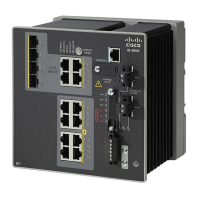2-239
Cisco IE 3000 Switch Command Reference
OL-13019-01
Chapter 2 IE 3000 Switch Cisco IOS Commands
mls qos srr-queue input priority-queue
mls qos srr-queue input priority-queue
Use the mls qos srr-queue input priority-queue global configuration command to configure the ingress
priority queue and to guarantee bandwidth on the internal ring if the ring is congested. Use the no form
of this command to return to the default setting.
mls qos srr-queue input priority-queue queue-id bandwidth weight
no mls qos srr-queue input priority-queue queue-id
Syntax Description
Defaults The priority queue is queue 2, and 10 percent of the bandwidth is allocated to it.
Command Modes Global configuration
Command History
Usage Guidelines You should use the priority queue only for traffic that needs to be expedited (for example, voice traffic,
which needs minimum delay and jitter).
The priority queue is guaranteed part of the bandwidth on the internal ring, which reduces the delay and
jitter under heavy network traffic on an oversubscribed ring (when there is more traffic than the
backplane can carry, and the queues are full and dropping frames).
Shaped round robin (SRR) services the priority queue for its configured weight as specified by the
bandwidth keyword in the mls qos srr-queue input priority-queue queue-id bandwidth weight global
configuration command. Then SRR shares the remaining bandwidth with both ingress queues and
services them as specified by the weights configured with the mls qos srr-queue input bandwidth
weight1 weight2 global configuration command.
To disable priority queueing, set the bandwidth weight to 0, for example, mls qos srr-queue input
priority-queue queue-id bandwidth 0.
Examples This example shows how to assign the ingress bandwidths for the queues. Queue 1 is the priority queue
with 10 percent of the bandwidth allocated to it. The bandwidth ratio allocated to queues 1 and 2 is
4/(4+4). SRR services queue 1 (the priority queue) first for its configured 10 percent bandwidth. Then
SRR equally shares the remaining 90 percent of the bandwidth between queues 1 and 2 by allocating 45
percent to each queue:
Switch(config)# mls qos srr-queue input priority-queue 1 bandwidth 10
Switch(config)# mls qos srr-queue input bandwidth 4 4
queue-id Ingress queue ID. The range is 1 to 2.
bandwidth weight Bandwidth percentage of the internal ring. The range is 0 to 40.
Release Modification
12.2(44)EX This command was introduced.
